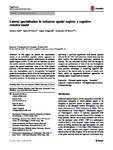Lateral specialization in unilateral spatial neglect: a cognitive robotics model
| dc.contributor.author | Conti, D | |
| dc.contributor.author | Di Nuovo, S | |
| dc.contributor.author | Cangelosi, A | |
| dc.contributor.author | Di Nuovo, A | |
| dc.date.accessioned | 2016-04-08T10:05:30Z | |
| dc.date.available | 2016-04-08T10:05:30Z | |
| dc.date.issued | 2016-08 | |
| dc.identifier.issn | 1612-4782 | |
| dc.identifier.issn | 1612-4790 | |
| dc.identifier.uri | http://hdl.handle.net/10026.1/4483 | |
| dc.description.abstract |
In this paper, we present the experimental results of an embodied cognitive robotic approach for modelling the human cognitive deficit known as unilateral spatial neglect (USN). To this end, we introduce an artificial neural network architecture designed and trained to control the spatial attentional focus of the iCub robotic platform. Like the human brain, the architecture is divided into two hemispheres and it incorporates bio-inspired plasticity mechanisms, which allow the development of the phenomenon of the specialization of the right hemisphere for spatial attention. In this study, we validate the model by replicating a previous experiment with human patients affected by the USN and numerical results show that the robot mimics the behaviours previously exhibited by humans. We also simulated recovery after the damage to compare the performance of each of the two hemispheres as additional validation of the model. Finally, we highlight some possible advantages of modelling cognitive dysfunctions of the human brain by means of robotic platforms, which can supplement traditional approaches for studying spatial impairments in humans. | |
| dc.format.extent | 321-328 | |
| dc.format.medium | Print-Electronic | |
| dc.language | en | |
| dc.language.iso | eng | |
| dc.publisher | Springer Science and Business Media LLC | |
| dc.subject | Unilateral spatial neglect | |
| dc.subject | Embodied cognition | |
| dc.subject | Cognitive robotics | |
| dc.subject | Hemisphere specialization | |
| dc.subject | Neuropsychology | |
| dc.title | Lateral specialization in unilateral spatial neglect: a cognitive robotics model | |
| dc.type | journal-article | |
| dc.type | Article | |
| plymouth.author-url | https://www.ncbi.nlm.nih.gov/pubmed/27018020 | |
| plymouth.issue | 3 | |
| plymouth.volume | 17 | |
| plymouth.publication-status | Published | |
| plymouth.journal | Cognitive Processing | |
| dc.identifier.doi | 10.1007/s10339-016-0761-x | |
| plymouth.organisational-group | /Plymouth | |
| plymouth.organisational-group | /Plymouth/Faculty of Science and Engineering | |
| plymouth.organisational-group | /Plymouth/Research Groups | |
| plymouth.organisational-group | /Plymouth/Research Groups/Institute of Health and Community | |
| plymouth.organisational-group | /Plymouth/Research Groups/Marine Institute | |
| dc.publisher.place | Germany | |
| dcterms.dateAccepted | 2016-03-10 | |
| dc.identifier.eissn | 1612-4790 | |
| dc.rights.embargoperiod | No embargo | |
| rioxxterms.versionofrecord | 10.1007/s10339-016-0761-x | |
| rioxxterms.licenseref.uri | http://www.rioxx.net/licenses/all-rights-reserved | |
| rioxxterms.licenseref.startdate | 2016-08 | |
| rioxxterms.type | Journal Article/Review | |
| plymouth.oa-location | http://link.springer.com/article/10.1007/s10339-016-0761-x |


